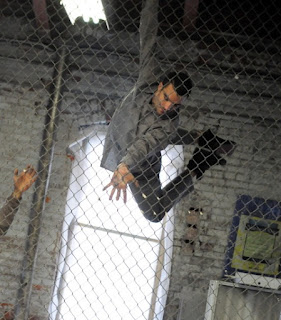Familiar Terrain
Native Haligonian Rebecca Lazier is a Senior Lecturer at Princeton University and the artistic director and choreographer of TERRAIN, a NYC dance company. This week she returns to her hometown to present two works - Coming Together and Attica – at the David Mack Murray Studio at the Dalhousie Arts Centre in Halifax.
How and when did you get involved with dance?
I started dancing here in Halifax when I was five. By the time I was 7 I was taking classes at several of the studios in town so I could dance more. From 10-13 I trained with Clare Bader of Halifax Ballet Theatre and then went to the Royal Winnipeg Ballet. I moved to New York at 18 to attend The Juilliard School - I haven't really stopped since I was five.
Are they the same reasons you do it today?
Yes and no. When I was young I was enthralled with the sheer joy of movement and the challenge of perfecting movement. Some of the reasons I dance, choreograph and teach today are certainly the same as those early inspirations, but then I had very little sense of the breadth of the field of dance. My reasons to dance now are much broader and permeate many different types of activities: I choreograph dances; teach technique, composition, theory, and history; I dance myself and I am writing a book about teaching.
What are the challenges of the profession?
Aside from the obvious challenges of the lack of financial security, a major challenge in dance is to learn to care for your instrument, your body, not only to be able to push yourself to new levels of dancing but also to avoid injury. You must continue to learn about your body, your habits, and be disciplined to do necessary training to stay in balance and health.
What are the rewards?
The rewards of performing and teaching are what push me to continue to make work and teach. When audiences describe their experiences of watching my work, or when students discover a new possibility, I feel I have been able to make a contribution to their understanding of self.
Why did you choose this particular production?
We are performing two complete dances on two separate concerts, Coming Together/Attica for Live Art and I Just Like This Music for Scotia Festival. Coming Together/Attica was inspired by the music score and I Just Like This Music, was inspired by the physical idea of making movement that is "un-inevitable." CT/A is a challenging piece of music, both to play and listen to, as there is a great deal of repetition that can feel oppressive. I was inspired by the combination of emotional strength, rigorous structure and political overtones in the score. For I Just Like This Music, we worked for several months creating movement material that would felt surprising and disrupted. It was only once I had all of the material I realize I wanted a lush, emotional and nostalgic score. The romantic Tchaikovsky's score is a background, more of an environment that we are dancing in versus music we are dancing to. Some sections use the music in an ironic way, other moments play with correlating notes and steps.
What are some of the themes explored in these works?
CT/A is dark. People try to box others in, they drag each other and push them down, they slip into the recesses of their minds, and are overtaken by bursts of movement. Yet, the ending is exhilarating and hopeful, filled with a crescendo of movement repeated over and over. My hope is that audiences will experience empathy and recognition. The score features a speaker who is reading a letter from a prisoner about life in prison. The confinement of the score is echoed in the confinement of the space. We are performing in a small black box where the audience is situated in the same imaginary space as the audience. This piece spoke to me not because of its overt drama or a desire to make a piece about the prison crisis (as there is a huge prison crisis in the states) but because I recognize the isolation and wanted to question what are the barriers we put between ourselves and others. Some walls are real, other imaginary. IJLTM is uplifting and yet looks at the sadness and joy that can accompany nostalgia. The content deals with having expectations and goals that you question. During the course of the dance the theater is deconstructed and the dancers move from formal, structured attire to free, funky wear that suit their personalities. By the end I want people to feel like they can, and should, get up and dance.
What are your thoughts on the state of dance in Atlantic Canada today?
Much like New York City, Halifax has groups of independent artists working on interesting projects. While there may not be extensive infrastructure for many full-time dance groups, the many schools and choreographers here are keeping the scene active and growing. Nova Scotia needs a university dance department, a degree program where the young promising students can be educated without leaving the province and a place that can attract leading choreographers and educators. NCASD students and faculty feed the artistic community of Halifax, as does the Dal drama program, dance needs to come into its own as an art form. The establishment of a dance degree would be help bring security and longevity to the development of field.
What's next on your creative agenda?
I have a trio in the works that is based on one movement. We recently returned from a three week tour of Turkey where we were able to rehearse and perform the first versions of the piece. My pieces frequently take 2 years to develop fully. I will commission a composer for this piece and be collaborating with a video artist. This fall I am staging a dance on students at Princeton, mentoring the senior choreographers, and hopefully finishing the draft of my book!
Coming Together / Attica, May 30 – June 2, 2012 8PM
David Mack Murray Studio, Dalhousie Arts Centre, Halifax


